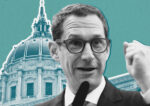“Congratulations San Francisco!”
R.J. Hottovy, head of analytical research at Placer.ai
Second-to-last place isn’t usually something to crow about, but when it comes to San Francisco and return-to-office trends, the small victory could be an indication that the city’s commercial market is past the bottom as well.
For the first time since Placer.ai began tracking office visits in the early days of the pandemic, San Francisco has bested another major U.S. city in RTO figures. The city had 47.5 percent fewer office visits in February 2025, compared with the pre-Covid month of February 2019, while Chicago saw a 48.5 percent decline in the same time period.
The nationwide figure is off 36.3 percent, with top markets like New York and Miami only 17 percent and 20 percent behind their respective 2019 office visits. The figures are based on cell phone data from about 1,000 office buildings across the country, typically about 100 buildings per market, and do not include government properties for privacy and security reasons.
Chicago and San Francisco have been the bottom two markets for RTO while New York City and Miami have been at the top since the location analytics company began tracking office visit data in early 2021, according to R.J. Hottovy, head of analytical research at Placer.ai. The Windy City’s freezing February and the commute-snarling construction on its roadways, along with tech employers pushing more days in office, may have finally lifted San Francisco out of last place, said Hottovy, who is based in Chicago.
“Congratulations San Francisco!” Hottovy joked of the second-to-last victory. “It’s been a horse race between these two markets for some time now.”
In addition, while Placer.ai data shows that RTO appears to be stalling out in many cities, San Francisco is still improving. Nationwide, there was a 6.3 percent drop in office visits in February 2025 compared to February 2024, and only 3.5 percent of that drop can be attributed to last year’s extra day for Leap Year. But San Francisco figures were only down 1 percent, the third-best in the nation after Miami and Boston, which were both at about half a percent below last year. Chicago office visits were down 8.2 percent in that same period.
“There are green shoots everywhere in San Francisco, and these numbers are an early indication that we are moving in the right direction,” Mayor Daniel Luire, who recently set an April 28 deadline for city workers to be in-office four days a week, told The Real Deal. “Our administration is leading by example, and many of our partners in the private sector are on the same page, bringing workers back to the office and kickstarting our downtown recovery.”
San Francisco Chief Economist Ted Egan cautioned that Placer.ai’s office data “shows a lot of volatility” from month to month, and is just one indicator of RTO strength. But combined with other data points, like increased transit ridership and office demand, it adds up to “good news for the city’s continuing economy recovery,” he said.
Hottovy agreed that he’d like to see a few more months of improved office visit data before he could call the RTO improvement a true trend, but that even this first month out of last place is “encouraging.”
Population numbers have recently started to rise in the city, he said, and tech mandates on RTO will continue to have a big impact as well.
“Maybe there’s some hope,” he said. “Maybe this is the first month of more pronounced recovery in terms of return to office, but it really is too soon to say.”
There were 2.2 million square feet of office leased in San Francisco in the first quarter of 2025, according to early data from CBRE, slightly less than the fourth quarter of 2024 but 50 percent higher than the full first quarter of 2024. If San Francisco continues on this leasing trajectory, it will exceed the 8 million square feet leased in all of 2024, according to Colin Yasukochi, executive director of data for CBRE.
There were about 5 million square feet of office requirements in the first quarter, which is lower than previous quarters, but represents the highest level of company expansions since the pandemic at just over 20 percent of the total. Almost all of that growth demand is coming from the 30 AI companies which are seeking a combined 1 million square feet of office space in the city, Yasukochi said.
Investors certainly seem to be betting on San Francisco’s recovery, according to Yardi data. San Francisco was the third-priciest market nationally, with office properties trading at $282 per square foot in the first two months of the year, compared with $177 per square foot nationally and $67 per square foot in Chicago.
Read more



